|
The Castle on the Rock
Spend a day enjoying this crown jewel of the Rock River Valley.

A broadwalk stairway allows visitors to access the scenic overlook of the Rock River without damaging the St. Peter
sandstone. While the park derives its name from the rock formation, more than 80 percent of the site is
forested, like the picknic area |
|
When you think of Illinois, you probably think of the word "flat." But when you drop into the Rock River Valley in northern Illinois, you can leave thoughts of "flat" behind. This valley is comprised of rolling hills and rocky outcroppings on either side of the Rock River.
Leave behind thoughts of rich, black, fertile soil, too. The glaciers didn't reach this part of Illinois as often as they reached the central part. The soil here tends to be silt and sandy loams, prone to heavy erosion and not nearly as rich as other Illinois soils. Rather than corn and beans, you're more likely to see pastures and large tracts of timber. In fact, this is a land more reminiscent of Wisconsin or New Hampshire.
But beauty abounds, and one of the prettiest places in the valley is Castle Rock State Park. Located along the Rock River 4 miles south of Oregon, this area was described as "a unique wilderness remnant of great natural beauty and scientific interest" when the park was dedicated in 1978.
Native Americans inhabited this part of the Rock River Valley for around a thousand years. The Sauk and, Fox tribes, who were living in the region when the first Europeans, arrived, called the area "Sinnissippi," meaning "rocky waters."
These tribes-were forced to move westward when settlers from New England moved into the region in the early 1800s. However, in 1831, a Sauk chief named Blackhawk led his tribe back into Illinois and battled the settlers in an attempt to reclaim ancestral lands. These Blackhawk Indian wars ended when the chief was captured and ordered to a reservation.
Castle Rock was proposed as a state park as far back as 1921, and a group called Friends of our Native Landscape even acquired some land at that time. The Natural Lands Institute, a not-for-profit preservation group, began raising funds to preserve a part of the area in 1964. The site was recognized by the State of Illinois as an "outstanding area of major scientific importance" in 1965. Land acquisition began in earnest in 1970.
You'll notice the "great natural beauty" at Castle Rock immediately.
The park feature's scenic terrain, with deep ravines and rock formations. But here's the irony: The nigged features that attract us to the site, comprise a very fragile ecosystem..
"The rock here is St. .Peter sandstone," said Grant. Afflerbaugh, the Site's superintendent for the past 23 years. "This type of. sandstone is not very durable. You can pick up a piece of rock and literally reduce it to sand in just a few minutes of rubbing. It is one of the few places in the state where it comes to the surface. It makes a very high-quality sand. In fact, one of the reasons the site was purchased in the first place was to protect the unique ecosystem from mining."
The ecosystem's fragile nature is the reason the state park has only limited development on its 2,000 acres. More than 700 of those acres are a dedicated nature preserve.
But don't let this talk about "fragile" deter you. Castle Rock State Park definitely is worth a visit. Situated along one of the widest stretches of the Rock River. it is one of the most beautiful parks in the state. More than 80 percent of its land is forested, including nearly all of the area's nature preserve. The site's rocks, hills and hardwood forests appeal to anyone in love with the outdoors.
|
12 OutdooIllinois
|
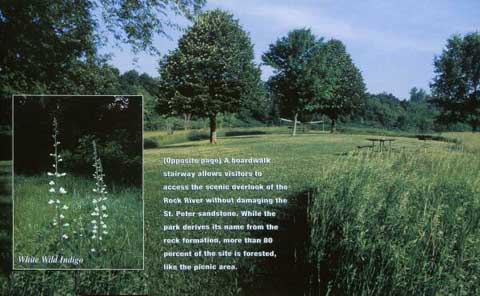
A large, sandstone bluff adjacent to the river is the park's signature attraction. Called Castle Rock, it rises up about 150 feet above the river, allowing for a spectacular view of the countryside. Keep in mind, however, that this is a fragile area, and climbing on the rock itself is strictly prohibited. There is a boardwalk stairway leading to the top, and plans are to enlarge the parking lot and put in a new stairway this summer.
If the climb looks too imposing, there is a second, smaller overlook across the parking lot from Castle Rock that also offers a nice view of the Rock River.
This area of the park also is a popular picnic and fishing spot. There are tables and fire rings scattered along the river's edge below the rock near the parking area.
Illinois Route 2, which is considered one of the state's most scenic drives from Sterling to Rockford, especially during the fall months, passes through the park. Visitors are urged to watch their children and to pay close attention to traffic when crossing the roadway.
The park has limited road access—only about 1/2 miles, so the best way to explore is by foot. There are approximately 6 miles of hiking trails—3 miles at the north end and 3 miles at the south end. Both trails wind through the rolling oak/hickory forest and past beautiful rock outcroppings, ravines and other scenic spots. (These same trails are available for cross-country skiing during the winter months.) The park also has a 2-mile-long, self-guided nature trail.
You're welcome to explore the park's nature preserve, but don't expect it to be an easy walk. No development is allowed in nature preserves, so there are no trails. Keep in mind, too, that it's heavily timbered and full of ravines. The preserve is a unique site featuring a number of plants usually associated with more northerly climes. In one valley, more than two dozen different types of ferns have been identified. The preserve also is home to several rare and endangered plants, the most unique being the oak fern. There also is at least one rare amphibian living there.
Castle Rock State Park is one of the state's designated wildlife viewing sites, so you're likely to see numerous woodland animals, such as raccoons, rabbits, foxes, squirrels and white-tailed deer. You're also likely to see Canada geese, ducks of all kinds, bluebirds, wild turkeys and various raptors, including bald eagles.
|
May 2002 13
|
"We have both bluebird and wood duck nesting boxes scattered around in the park," Afflerbaugh said. "We've always had eagles here through the winter months, and now we're starting to see a few during the warmer months as well. Two nests have been documented in the area."
Hunting and Fishing
There are limited hunting opportunities at the park for squirrel, wild turkeys and white-tailed deer. Turkey and deer hunters are required to obtain site-specific permits. For regulations and more information, contact the park office.
The park also is in the midst of a deer reduction program.
"We have a large deer herd at the park," Afflerbaugh said. "At one time, biologists estimated that we had about 100 deer per square mile. The herd was so over-populated that it was beginning to destroy the park's vegetation. We're trying to reduce deer numbers slowly by allowing 50 hunters per day during the 10 days of firearm hunting. We've taken 400 deer from the park in the past three years."

For safety reasons, Afflerbaugh said the park is closed to all other activities during the state's seven-day firearm deer hunting season and the three-day muzzleloading season.
The park has a couple of ponds and wetland areas that are not suitable for fishing. But anglers should find the Rock River much to their liking. The park includes 1_miles of river frontage, and there are four or five areas where vehicles can pull off the highway for river access. Picnic tables and firepads are conveniently situated along the river.
The Rock River boasts of some of the best flathead and channel cat fishing in the state. Testament to the quality of the fishing can be found weekend. The river has good current along the park frontage, and anglers enjoy catches of northern pike, walleye, sauger and crappie. This is an excellent area for catching both smallmouth and largemouth bass, but anglers should keep in mind that this stretch of the Rock River is part of an experimental "catch and release" area for those species.
While most anglers seem to opt for fishing from the shore, there is a
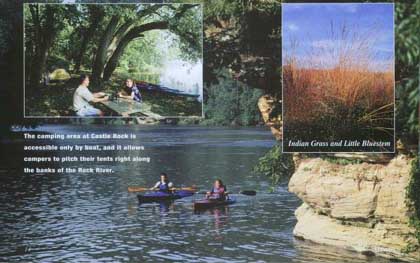
(left in abov pic) The camping area at Castle Rock is accessible only by boat, and it allows campers to pitch their tents right along the banks of the Rock River
(right in above pic) Indian Grass and Little Bluestem
|
14 OutdoorIllinois
|
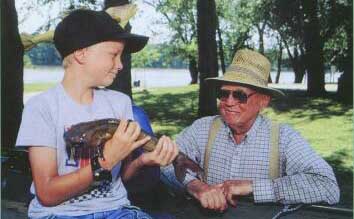
Leigh Tipton proudly displays the channel catfish he caught to his grandfather, Sherman Tipton.
boat ramp available at the park. The river is very shallow here, which makes it a poor area for power boating. Most people who launch here are in small boats and canoes.
There also are a few small islands that are a part of the state park and accessible only by boat. Afflerbaugh said some anglers go out to the islands to fish there.
|
Information you can use
Address: Castle Rock State Park, 1365 W. Castle Road, Oregon, IL 61061.
Telephone: (815) 732-7329.
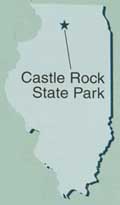
Directions: Locate in Ogle County jus 20 miles south-west of Rockford, Castle Rock is on Illinois Route 2, about 3 miles south of Oregon and 12 miles north of Dixon
Website: http://dnr.state.il.us/lands/
Landmgt/PARKS/R1 /CASTLE. HTM
Other nearby attractions:
Ronald Reagan's Boyhood Home—Built in 1891, President Ronald Reagan's boyhood home in Dixon has been restored, and guided tours are available February through November. Telephone: (815) 288-5176.
Lowell Park Nature Center/Heritage Museum—This Dixon museum focuses on natural resources education and includes exhibits on native plants and wildlife, plus it features live birds of prey. Telephone: (815) 288-5209.
John Deere Historic Site—Visit the home where John Deere lived when he invented the first self-scouring plow, plus his blacksmith shop in Grand Detour. Open April 1-Oct. 31. Telephone: (815) 652-4551.
Blackhawk Statue—Located in Lowden State Park, near Oregon, this 48-foot-tall statue of an American Indian by Lorado Taft is best viewed from the north edge of Oregon looking across the river from Illinois Route 2. Then visit the park for a close-up view. Telephone (815) 732-6828.
|
Picnic Areas
On top of a hill and over-looking the river is the Valley View picnic area. In addition to a shelter and numerous picnic tables and firepads, it includes a playground, horseshoe pit and volleyball area. The hill is used for sledding and tobogganing during the winter months.
Old Orchard picnic area is located in what formerly was an orchard. Some of the original fruit trees still exist, and others have been planted. Visitors are allowed to take fruit for personal use. Old Orchard includes a playground, horseshoe pits, a volleyball field, a small softball field and a shelter. It also is accessible with sidewalks leading to the facilities and other amenities designed for disabled visitors.
Each picnic area includes toilet facilities and drinking water. Two of the park's shelters can be reserved for a small fee by contacting the park office in advance. Although no electricity currently is available at either site, there are plans to add this amenity in the near future.
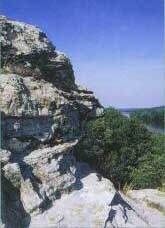
Riverbank Camping
One of the park's most unusual features is its campground. It's not for everyone, however, as it is accessible only by water. The campground is primitive and right along the river. There are nine camp sites, plus a small group camping area.
"The campground gets a lot of use, especially on the weekends during the summer months," Afflerbaugh said. "People like it because they can camp right along the river's edge. There is a small dock area to tie up boats, and a firepad for each campsite. The cost is $6 a night. But keep in mind this is very primitive. There are portapotties, but no water."
With about 200,000 visitors each year, Castle Rock State Park can be a busy place, especially during summer weekends. We're betting that if you visit there once, its beauty will have you returning to this Rock River treasure time and again.
|
Gary Thomas is the former editor of Outdoorllinois.
|
|
May 2002 15
|

